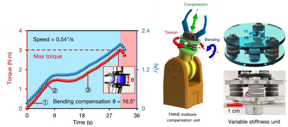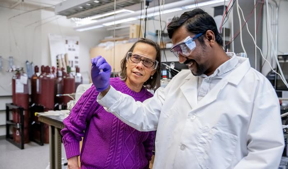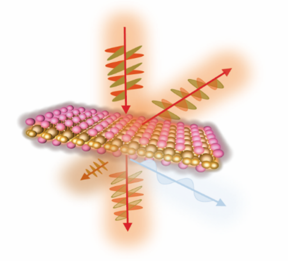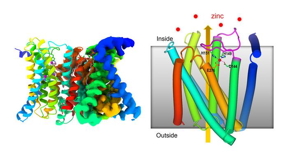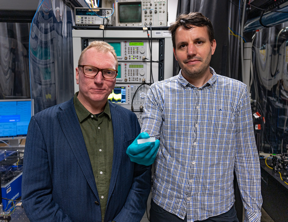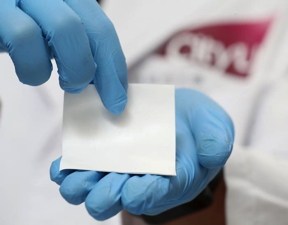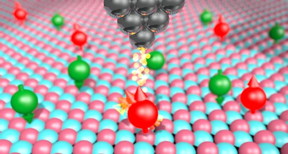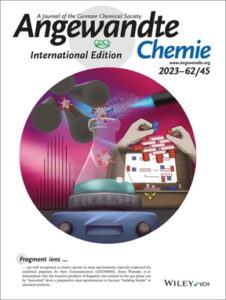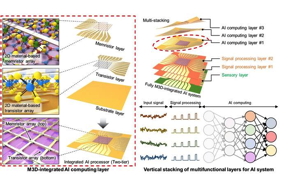Home > Press > Porous platinum matrix shows promise as a new actuator material
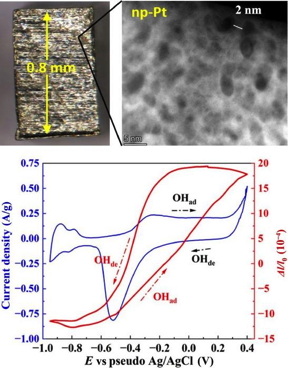 |
| Microscopic structure and actuation performance of nanoporous platinum (np-Pt) (IMAGE) TSINGHUA UNIVERSITY PRESS Microscopic structure and actuation performance of nanoporous platinum (np-Pt) CAPTION Np-Pt is made up of interconnected small-diameter ligaments, or strands, of platinum as small as two nanometers (10-9 m) in diameter with tiny pores in between. The small nature of the platinum ligaments and the numerous tiny pores improve the structural stability of the material and its energy conductivity, as indicated by the graph illustrating current density, or the amount of charge flowing through a particular area in a given time, and relative length change. CREDIT Energy Materials and Devices, Tsinghua University Press |
Abstract:
Actuators are common machine components that convert energy into movement, like the muscles in the human body, vibrators in mobile phones or electric motors. Ideal actuator materials need good electrochemical properties to repeatedly conduct electrical currents made of flowing electrons. In addition, actuator materials require excellent mechanical properties to withstand the physical stress associated with continual movement. Nanoporous platinum (np-Pt), a platinum matrix containing tiny pores to increase energy conduction, was recently created in large quantities and in a cost-efficient manner, making np-Pt an ideal and more practical actuator material.
Porous platinum matrix shows promise as a new actuator material
Tsinghua, China | Posted on November 17th, 2023A group of material scientists from Hamburg University of Technology in Hamburg, Germany manufactured an ultrafine-ligament np-Pt material made up of a random, interconnected network of very fine platinum strands, or ligaments, as small as two nanometers (10-9 m) in diameter. This network also creates tiny pores between the strands, which improves the movement of electrons or charged atoms through the material. Importantly, the team used an efficient manufacturing method that decreased the cost associated with synthesizing a np-Pt. By decreasing the diameter of the Pt strands, both the surface-to-volume ratio and the mechanical stability of the np-Pt material goes up, improving the material’s actuator performance.
The researchers published their study in Energy Materials and Devices, on October 17, 2023.
Compared to other nanoporous metals and materials being investigated for their potential use as actuators, the team discovered that np-Pt was physically more robust and would likely work well as a sensor or detector material versus other nanoporous materials that are too fragile.
“The fine ligament size of np-Pt could provide an enhanced surface area which makes the material a promising… catalyst of chemical reactions as well as an actuator material,” said Haonan Sun, first author of the paper and researcher in the Research Group of Integrated Metallic Nanomaterials Systems at Hamburg University of Technology. As a catalyst, np-Pt would speed the rate of specific chemical reactions.
What was most unique about the study was how the researchers manufactured the np-Pt material. “The main breakthrough in this research is that we obtained bulk np-Pt by electrochemical dealloying. Past studies on np-Pt were all based on nanoparticles or films that were prepared using more expensive commercial Pt particles. So the easy and cheap method of dealloying increases the practicality of np-Pt and makes further research possible,” said Sun.
Specifically, dealloying is a process of selective leaching or corrosion where one component of an alloy, or material blend, is selectively removed from the material. Before the dealloying process, the material is a uniform blend. After the selective leaching process, the more chemically active of the blended materials is partially removed from the material, leaving tiny pores behind. In this case, np-Pt was manufactured by selectively leaching copper from a platinum-copper alloy (Pt15Cu85) using sulfuric acid (H2SO4).
Prior to this study, np-Pt had also never been manufactured in larger bulk quantities. The research team suggests that the successful performance of bulk np-Pt serves as a model for the development of other nanoporous metals that may be investigated for their suitability as potential actuator materials, strain sensors or chemical reaction catalysts.
With the actuator material performance of np-Pt established, the team looks forward to determining the effects of the material on chemical reactions. “The next step of this study is to investigate the chemical catalyst property of our np-Pt. We have already found some very interesting phenomena with bulk np-Pt on the oxygen reduction reaction which combines oxygen and hydrogen to form water… and we would like to do some deeper research on that,” said Sun.
Other contributors include Yizhou Huang from the Research Group of Integrated Metallic Nanomaterials Systems at Hamburg University of Technology in Hamburg, Germany and Shan Shi from the Research Group of Integrated Metallic Nanomaterials Systems at Hamburg University of Technology and the Institute of Materials Mechanics at Helmholtz-Zentrum Hereon in Geesthacht, Germany.
####
About Tsinghua University Press
About Energy Materials and Devices
Energy Materials and Devices is launched by Tsinghua University, published quarterly by Tsinghua University Press, aiming at being an international, single-blind peer-reviewed, open-access and interdisciplinary journal in the cutting-edge field of energy materials and devices. It focuses on the innovation research of the whole chain of basic research, technological innovation, achievement transformation and industrialization in the field of energy materials and devices, and publishes original, leading and forward-looking research results, including but not limited to the materials design, synthesis, integration, assembly and characterization of devices for energy storage and conversion etc.
About SciOpen
SciOpen is a professional open access resource for discovery of scientific and technical content published by the Tsinghua University Press and its publishing partners, providing the scholarly publishing community with innovative technology and market-leading capabilities. SciOpen provides end-to-end services across manuscript submission, peer review, content hosting, analytics, and identity management and expert advice to ensure each journal’s development by offering a range of options across all functions as Journal Layout, Production Services, Editorial Services, Marketing and Promotions, Online Functionality, etc. By digitalizing the publishing process, SciOpen widens the reach, deepens the impact, and accelerates the exchange of ideas.
For more information, please click here
Contacts:
Mengdi Li
Tsinghua University Press
Office: 86-108-347-0580
Copyright © Tsinghua University Press
If you have a comment, please Contact us.Issuers of news releases, not 7th Wave, Inc. or Nanotechnology Now, are solely responsible for the accuracy of the content.
| Related Links |
| Related News Press |
News and information
![]() Inverted perovskite solar cell breaks 25% efficiency record: Researchers improve cell efficiency using a combination of molecules to address different November 17th, 2023
Inverted perovskite solar cell breaks 25% efficiency record: Researchers improve cell efficiency using a combination of molecules to address different November 17th, 2023
![]() Night-time radiative warming using the atmosphere November 17th, 2023
Night-time radiative warming using the atmosphere November 17th, 2023
![]() A new kind of magnetism November 17th, 2023
A new kind of magnetism November 17th, 2023
Chemistry
![]() Charged “molecular beasts” the basis for new compounds: Researchers at Leipzig University use “aggressive” fragments of molecular ions for chemical synthesis November 3rd, 2023
Charged “molecular beasts” the basis for new compounds: Researchers at Leipzig University use “aggressive” fragments of molecular ions for chemical synthesis November 3rd, 2023
![]() Ferroelectrically modulate the Fermi level of graphene oxide to enhance SERS response November 3rd, 2023
Ferroelectrically modulate the Fermi level of graphene oxide to enhance SERS response November 3rd, 2023
![]() USTC achieved dynamic imaging of interfacial electrochemistry August 11th, 2023
USTC achieved dynamic imaging of interfacial electrochemistry August 11th, 2023
![]() A non-covalent bonding experience: Scientists discover new structures for unique hybrid materials by altering their chemical bonds July 21st, 2023
A non-covalent bonding experience: Scientists discover new structures for unique hybrid materials by altering their chemical bonds July 21st, 2023
Possible Futures
![]() Shedding light on unique conduction mechanisms in a new type of perovskite oxide November 17th, 2023
Shedding light on unique conduction mechanisms in a new type of perovskite oxide November 17th, 2023
![]() Silver nanoparticles: guaranteeing antimicrobial safe-tea November 17th, 2023
Silver nanoparticles: guaranteeing antimicrobial safe-tea November 17th, 2023
![]() Three-pronged approach discerns qualities of quantum spin liquids November 17th, 2023
Three-pronged approach discerns qualities of quantum spin liquids November 17th, 2023
![]() Inverted perovskite solar cell breaks 25% efficiency record: Researchers improve cell efficiency using a combination of molecules to address different November 17th, 2023
Inverted perovskite solar cell breaks 25% efficiency record: Researchers improve cell efficiency using a combination of molecules to address different November 17th, 2023
Discoveries
![]() Inverted perovskite solar cell breaks 25% efficiency record: Researchers improve cell efficiency using a combination of molecules to address different November 17th, 2023
Inverted perovskite solar cell breaks 25% efficiency record: Researchers improve cell efficiency using a combination of molecules to address different November 17th, 2023
![]() Night-time radiative warming using the atmosphere November 17th, 2023
Night-time radiative warming using the atmosphere November 17th, 2023
![]() A new kind of magnetism November 17th, 2023
A new kind of magnetism November 17th, 2023
Materials/Metamaterials/Magnetoresistance
![]() A new kind of magnetism November 17th, 2023
A new kind of magnetism November 17th, 2023
![]() Ferroelectrically modulate the Fermi level of graphene oxide to enhance SERS response November 3rd, 2023
Ferroelectrically modulate the Fermi level of graphene oxide to enhance SERS response November 3rd, 2023
![]() Nanoparticle quasicrystal constructed with DNA: The breakthrough opens the way for designing and building more complex structures November 3rd, 2023
Nanoparticle quasicrystal constructed with DNA: The breakthrough opens the way for designing and building more complex structures November 3rd, 2023
Announcements
![]() Inverted perovskite solar cell breaks 25% efficiency record: Researchers improve cell efficiency using a combination of molecules to address different November 17th, 2023
Inverted perovskite solar cell breaks 25% efficiency record: Researchers improve cell efficiency using a combination of molecules to address different November 17th, 2023
![]() Night-time radiative warming using the atmosphere November 17th, 2023
Night-time radiative warming using the atmosphere November 17th, 2023
![]() A new kind of magnetism November 17th, 2023
A new kind of magnetism November 17th, 2023
Interviews/Book Reviews/Essays/Reports/Podcasts/Journals/White papers/Posters
![]() Inverted perovskite solar cell breaks 25% efficiency record: Researchers improve cell efficiency using a combination of molecules to address different November 17th, 2023
Inverted perovskite solar cell breaks 25% efficiency record: Researchers improve cell efficiency using a combination of molecules to address different November 17th, 2023
![]() Night-time radiative warming using the atmosphere November 17th, 2023
Night-time radiative warming using the atmosphere November 17th, 2023
![]() A new kind of magnetism November 17th, 2023
A new kind of magnetism November 17th, 2023
- SEO Powered Content & PR Distribution. Get Amplified Today.
- PlatoData.Network Vertical Generative Ai. Empower Yourself. Access Here.
- PlatoAiStream. Web3 Intelligence. Knowledge Amplified. Access Here.
- PlatoESG. Carbon, CleanTech, Energy, Environment, Solar, Waste Management. Access Here.
- PlatoHealth. Biotech and Clinical Trials Intelligence. Access Here.
- Source: http://www.nanotech-now.com/news.cgi?story_id=57425
- :is
- :not
- :where
- $UP
- 10
- 11
- 17
- 17th
- 2023
- 21st
- 30
- 3rd
- 7th
- a
- About
- accelerates
- access
- accuracy
- achieved
- achievement
- acoustic
- across
- active
- addition
- address
- advice
- After
- Aiming
- All
- Alloy
- already
- also
- amount
- an
- analytics
- and
- approach
- ARE
- AREA
- around
- AS
- Assembly
- associated
- At
- atom
- AUGUST
- author
- based
- basic
- basis
- BE
- been
- before
- behind
- being
- between
- Blend
- body
- both
- breaks
- breakthrough
- Building
- but
- by
- capabilities
- case
- Catalyst
- catalysts
- cell
- Center
- CGI
- chain
- change
- charge
- charged
- cheap
- chemical
- chemistry
- China
- click
- cold
- COM
- combination
- combines
- comment
- commercial
- Common
- community
- complex
- component
- components
- Conduct
- conducted
- conductivity
- content
- contributors
- Conversion
- convert
- Copper
- corrosion
- Cost
- could
- created
- creates
- credit
- Current
- cutting-edge
- decreased
- decreasing
- deepens
- deeper
- del
- density
- Design
- designing
- determining
- develop
- Development
- Devices
- discover
- discovered
- discovery
- dna
- do
- dynamic
- each
- easy
- Editorial
- effects
- efficiency
- efficient
- Electric
- electrons
- end
- end-to-end
- energy
- enhance
- enhanced
- ensure
- established
- etc
- Ether (ETH)
- excellent
- exchange
- expensive
- experience
- experiments
- expert
- field
- films
- fine
- First
- Flowing
- focuses
- For
- form
- Forward
- forward-looking
- found
- from
- functionality
- functions
- fundamental
- further
- futuristic
- Germany
- gif
- given
- Goes
- good
- graph
- Graphene
- Group
- had
- hamburg
- Have
- help
- helped
- hosting
- How
- HTML
- http
- HTTPS
- huang
- human
- Hybrid
- hydrogen
- ideal
- ideas
- Identity
- identity management
- if
- illustrating
- image
- Imaging
- Impact
- importantly
- improve
- improves
- improving
- in
- Inc.
- include
- Including
- Increase
- Increases
- indicated
- information
- Innovation
- innovative
- innovative technology
- Institute
- integrated
- integration
- interconnected
- interesting
- International
- international space station
- into
- investigate
- IT
- ITS
- journal
- jpg
- July
- Kind
- lab
- large
- larger
- laser
- launched
- Layout
- leading
- leaving
- Length
- lenses
- Level
- light
- like
- likely
- Limited
- links
- LOOKS
- machine
- made
- Main
- MAKES
- Making
- management
- manner
- manufactured
- manufacturing
- market-leading
- Marketing
- material
- materials
- Matrix
- May..
- mechanical
- mechanics
- mechanisms
- Metals
- method
- Mobile
- mobile phones
- model
- molecular
- more
- most
- Motors
- movement
- Nanomaterials
- nanotechnology
- Nature
- Need
- net
- network
- never
- New
- news
- next
- nicholas
- November
- now
- numerous
- obtained
- october
- of
- offering
- on
- ONE
- online
- open
- opens
- Options
- or
- original
- Other
- our
- Oxygen
- Paper
- particular
- partners
- past
- peer
- peer-reviewed
- performance
- phones
- PHP
- physical
- Physically
- platinum
- plato
- Plato Data Intelligence
- PlatoData
- please
- possible
- Post
- posted
- potential
- Practical
- prepared
- press
- Press Release
- probe
- process
- Production
- professional
- Professor
- promise
- Promotions
- properties
- property
- provide
- provides
- providing
- published
- Publishes
- Publishing
- qualities
- Quantum
- random
- range
- Rate
- ratio
- reach
- reaction
- reactions
- recently
- record
- reduction
- relative
- release
- Releases
- Removed
- REPEATEDLY
- require
- research
- research group
- researcher
- researchers
- resource
- responsible
- Results
- return
- review
- robust
- Said
- Save
- scientific
- scientists
- Search
- selective
- sensors
- serves
- Services
- setup
- Share
- Shows
- Size
- small
- So
- solar
- solely
- some
- Space
- space station
- specific
- speed
- Spin
- Stability
- start
- station
- Step
- storage
- Strands
- stress
- structural
- structure
- structures
- studies
- Study
- submission
- submit
- successful
- Suggests
- suitability
- Sun
- Surface
- synthesis
- Systems
- team
- Technical
- technique
- technological
- Technology
- that
- The
- The Graph
- the world
- their
- this
- Through
- time
- to
- too
- tools
- Transformation
- Tsinghua
- two
- type
- unique
- university
- us
- use
- used
- using
- Versus
- very
- was
- Wave
- Way..
- we
- WELL
- were
- which
- whole
- will
- with
- Work
- world
- would
- Yahoo
- you
- zephyrnet











